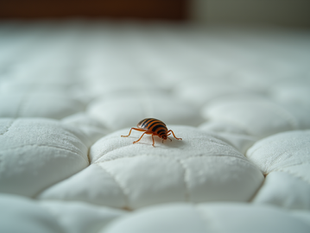
How to Identify the Signs of a Bed Bug Infestation
0
4
0
Bed bugs are tiny pests that can cause big problems in your home. They are experts at hiding and can multiply quickly if not detected early. Knowing how to identify the signs of a bed bug infestation is crucial to stopping them before they spread. This guide will help you recognize the most common bed bug signs and take action to protect your living space.
Understanding Common Bed Bug Signs
Bed bugs are small, reddish-brown insects that feed on human blood. They are nocturnal and usually come out at night to bite. Because they hide well, spotting them directly can be difficult. Instead, you should look for indirect signs that indicate their presence.
Some of the most common bed bug signs include:
Bite marks on your skin: These often appear as small, red, itchy bumps, usually in a line or cluster.
Blood stains on sheets or pillowcases: These occur when bed bugs are crushed after feeding.
Dark or rusty spots on mattresses and furniture: These are bed bug excrement.
Shed skins or eggshells: Bed bugs molt several times as they grow.
A musty, sweet odor: This smell comes from the bed bugs’ scent glands.
If you notice any of these signs, it’s important to act quickly to prevent a full-blown infestation.

Close-up view of a bed bug on mattress fabric showing its size and color
How to Perform a Thorough Bed Bug Inspection: Key Bed Bug Signs to Check
Performing a detailed inspection is the best way to confirm if you have bed bugs. Here’s a step-by-step guide to help you identify bed bug signs in your home:
Start with the bed: Remove all bedding and check seams, folds, and tags of your mattress and box spring. Use a flashlight to look for live bugs, eggs, or dark spots.
Inspect furniture: Bed bugs can hide in cracks and crevices of bed frames, headboards, nightstands, and chairs.
Check behind baseboards and electrical outlets: These are common hiding spots.
Look inside picture frames and under loose wallpaper: Bed bugs can squeeze into tiny spaces.
Examine luggage and clothing: If you’ve recently traveled, bed bugs may have hitched a ride.
During your inspection, use a magnifying glass if possible. Pay close attention to any unusual stains or tiny shells. If you find evidence of bed bugs, it’s time to consider professional help.

High angle view of mattress seams being inspected with a flashlight for bed bug signs
Using a professional bed bug inspection service can save time and ensure a thorough check. Experts use trained dogs and specialized equipment to detect infestations early.
What to Do If You Find Bed Bug Signs
Discovering bed bug signs can be stressful, but acting quickly is key to controlling the problem. Here are practical steps to take if you suspect an infestation:
Isolate the affected area: Avoid moving items from the infested room to other parts of your home.
Wash and dry bedding and clothing: Use hot water and high heat to kill bed bugs and eggs.
Vacuum thoroughly: Focus on mattresses, carpets, and furniture. Dispose of the vacuum bag immediately.
Declutter your space: Reducing hiding spots makes treatment more effective.
Contact a professional: A certified pest control company can provide safe and effective treatment options.
Avoid using DIY pesticides without guidance, as improper use can worsen the problem or pose health risks. Professional treatment often includes heat treatments, insecticides, or a combination of methods tailored to your situation.
Preventing Future Bed Bug Infestations
Once you’ve dealt with an infestation, prevention is the best way to avoid a repeat. Here are some tips to keep bed bugs away:
Inspect secondhand furniture carefully before bringing it into your home.
Use protective covers on mattresses and box springs.
Be cautious when traveling: Inspect hotel rooms and keep luggage off the floor.
Regularly clean and vacuum your home.
Seal cracks and crevices where bed bugs can hide.
Early detection is crucial. Regularly check for bed bug signs, especially if you live in multi-unit housing or travel frequently.
By staying vigilant and knowing what to look for, you can protect your home from these unwelcome pests.
Identifying bed bug signs early can save you time, money, and stress. Use this guide to perform thorough inspections and take prompt action if you find evidence of bed bugs. Remember, professional help is available, and a reliable bed bug inspection service can make all the difference in keeping your home bed bug-free.






